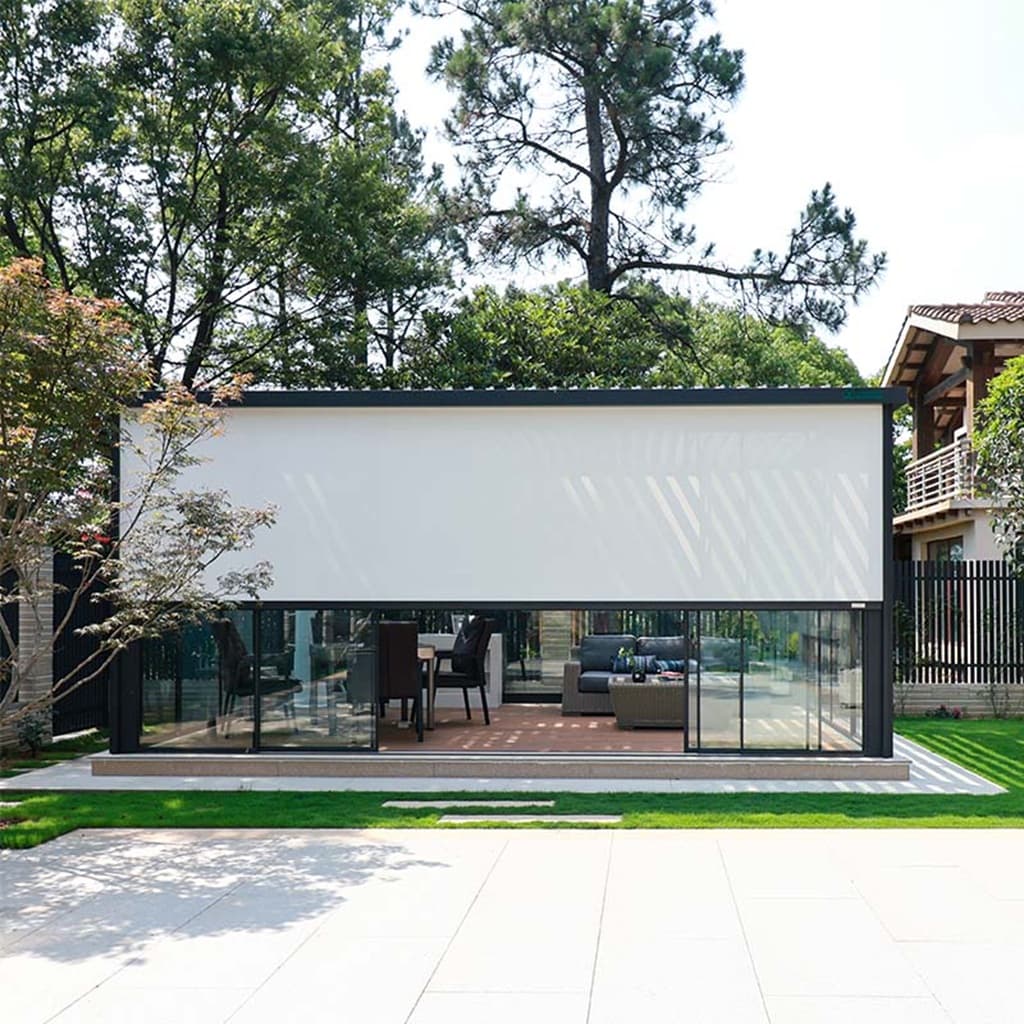Essential Maintenance Tips for Manual Zip Screens

Regular cleaning, checking, and gentle care help your Mauanl Zip Screen work well. Think about having trouble lifting your manual drop screens or seeing torn fabric after a windy day. You can stop these problems with easy tips at home. Many owners have:
-
Trouble using screens because dust or dirt gets in the mechanism
-
Screen problems like holes, sagging, or ripped edges
-
Track or frame issues, like bending or rust
You keep your screens safe and save money on repairs by acting early. Simple care makes your Mauanl Zip Screen last longer and work better.
Key Takeaways
-
Clean your manual zip screens every three months. Use mild soap and water. This stops dirt from building up. It helps them work well.
-
Check your screens often for small tears. Look for dirt in the tracks or loose parts. This helps you find problems early. It can stop expensive repairs.
-
Move the screens gently when you use them. Do not use them during strong winds or icy weather. This keeps them from getting damaged.
-
Put silicone spray on moving parts. Keep the tracks clear of dirt and debris. This helps the screens move smoothly. It also makes them last longer.
-
Call a professional for big repairs. This includes bent frames, broken cables, or large fabric tears. This protects your screens. It also makes sure repairs are safe.
Why Maintenance Matters
Protecting Your Manual Zip Screen
You want your mauanl zip screen to last for years. Regular maintenance helps you protect your investment. Industry best practices show that cleaning, inspecting, and fixing small problems early can make mechanical equipment last much longer. These same ideas work for retractable exterior screens. When you care for your screens, you stop small issues from turning into big repairs. You also keep your outdoor retractable screens looking new and working well.
Tip: Always check your screens after storms or windy days. Early action prevents damage.
Environmental factors can harm your screens. The most common problems come from:
-
Debris in the tracks, which blocks proper operation
-
Bad weather, which stretches or wears out the fabric
You can avoid these issues by raising your screens during storms and cleaning the tracks often.
Preventing Issues
Proper maintenance helps you avoid many common issues. You might see dirt, leaves, or bugs in the tracks of your retractable exterior screens. If you ignore these, your screens may jam or become hard to use. Cleaning the guides and checking for damage keeps your manual drop screens in good shape. You also save money because you do not need to replace parts as often.
Note: Small problems, like a wrinkle or a little noise, can grow into bigger issues if you do not fix them right away.
Ensuring Smooth Operation
You want your retractable screens to move up and down easily. Regular cleaning of the fabric and guides stops dirt from building up. Twice a year, inspect the tension and check that all fasteners are tight. Remove any objects from the guides to avoid noise or sticking. Do not use your screens in strong winds or when the guides are icy. These steps help you enjoy proper operation and a smooth experience every time.
A little care goes a long way. With proper maintenance, your screens will work better and last longer.
Maintenance Routine

Pre-Cleaning Steps
Before you start cleaning your mauanl zip screen, take a few simple steps to protect the fabric and frame. Remove any loose debris from the surface and tracks. Use a soft brush or your hand to clear away leaves, dust, or bugs. Make sure the area around your screens is safe and free from obstacles. Always check for signs of damage before you begin. If you see tears or sagging, handle the screen gently to avoid making the problem worse.
Tip: Wear gloves to protect your hands and avoid touching sharp edges or rusted hardware during inspection.
Cleaning Fabric and Frame
You keep your screens looking fresh and working well with regular cleaning. Follow these steps for best results:
-
Wet the screen with a hose or dip a soft sponge in mild soapy water.
-
Gently scrub the fabric in circular motions, focusing on stains or dirty spots.
-
Rinse the screen with clean water to remove soap and dirt.
-
Wipe off excess water using a microfiber cloth or soft towel.
-
Let the screen air dry. Do not use heat or force.
-
Avoid pressure washers and harsh chemicals. These can damage the fabric and frame.
-
Treat stains quickly to prevent permanent marks.
-
For algae, use a diluted vinegar or bleach solution. Scrub gently and rinse well.
Regular cleaning helps prevent mildew and keeps your retractable screens in top shape. If you notice stubborn stains, consider professional cleaning to avoid harming your manual drop screens.
Cleaning Side Guides and Tracks
Side guides and tracks need monthly cleaning to stop dirt and debris from causing problems. Use a vacuum with a soft brush or canned air to remove loose particles. Wipe the tracks with a damp cloth sprayed with a gentle cleaner. Do not spray cleaner directly on the tracks. Avoid abrasive scrubbing, which can scratch the surface. Never use oil, grease, or petroleum sprays. These attract dirt and make operation harder.
Note: Cleaning and inspecting screens regularly helps prevent debris in the tracks from blocking movement.
Lubricating Moving Parts
Lubrication keeps your outdoor zip screen working smoothly. Clean the zipper before you apply any lubricant. Choose the right product for your retractable screens:
|
Description & Use Case |
Pros |
Cons |
|
|---|---|---|---|
|
Dedicated Zipper Lubricant |
Wax-based stick for zippers; works on metal and plastic |
Purpose-designed, does not stain fabric |
May not fix jammed zippers |
|
Silicone Lubricants |
Works on metal and plastic zippers |
Effective, suitable for most zippers |
Can stain fabric if over-applied |
|
Cooking Oils |
Olive or vegetable oil with a Q-tip |
Easy to find, simple to use |
Can spoil, may stain fabric |
|
Wax or Soap |
Bar soap or crayon wax |
Good lubrication, easy to wipe off |
Colored wax may leave residue |
|
Household Items |
Chapstick, Vaseline, liquid soap, graphite pencil |
Useful in a pinch |
May leave residue or fragrance |
Apply lubricant sparingly and wipe away any excess. Do not use petroleum-based sprays like WD-40. These can damage plastic parts and attract dirt.
Inspecting for Damage
Inspection is a key part of maintenance. Look for missing or rusted hardware, loose cables, or tension problems. Check for small tears, holes, wrinkles, or stretching in the fabric. If you find minor damage, use a screen repair kit to patch holes or tears. Gently stretch the screen to fix wrinkles. Address problems early to keep your exterior screens strong.
Tip: If you see major damage, such as broken cables or bent frames, call a professional for repairs.
Regular inspection and cleaning help you spot issues before they get worse. Keep your waterproof clear PVC blind safe by checking them often and fixing small problems right away.
Troubleshooting Common Issues

Manual zip screens can face several problems over time. You can solve many of these at home with simple troubleshooting steps. This section covers the most common issues and how you can fix them safely.
Difficulty Operating
You may notice your screen feels stuck or hard to move. This problem often happens when dirt or debris builds up in the tracks. Sometimes, the handle may not move smoothly, or you hear a crumpling sound.
To solve this:
-
Gently pull the screen out for use. Do not yank or force it.
-
If you feel resistance or hear a strange sound, reverse your action. Push if you were pulling, or pull if you were pushing.
-
Make sure the front handle stays vertical. Both wheels should touch the floor.
-
Never force the handle. If you need to use force, stop and check for blockages.
-
If the screen still does not work, contact the manufacturer for help.
Tip: Always use gentle movements. Forcing the screen can cause damage to the mechanism.
Fabric Damage
Fabric damage can include tears, holes, or fraying edges. These problems often start small but can get worse if you ignore them. Strong winds, sharp objects, or rough handling can cause these issues.
To fix minor fabric damage:
-
Clean the area around the tear with mild soapy water.
-
Let the fabric dry completely.
-
Use a screen repair kit or patch to cover small holes or tears.
-
For larger damage, call a professional for repair or replacement.
Note: Avoid using harsh chemicals or scrubbing hard. These actions can weaken the fabric and make the problem worse.
Track and Zipper Issues
Track and zipper problems often make your screen jam or move unevenly. Friction and wear from the bead-and-rail Keder system can cause these issues. Over time, the material wears down, especially in long or curved tracks. Wind pressure can also push the zipper beads out of place, leading to jams or hang-ups.
You can prevent and fix these problems by:
-
Cleaning the tracks and zippers regularly to remove dirt and debris.
-
Checking for signs of wear or misalignment.
-
Applying a silicone-based lubricant to the tracks and zippers for smoother operation.
-
Making sure the zipper beads stay in place during use.
If you notice repeated jams or the zipper pops out often, you may need to replace worn parts or seek professional help.
Warning: Never use aggressive cleaning agents or forceful methods on the tracks or zippers. These can cause permanent damage.
Sagging or Tension Problems
A sagging screen or one that feels loose often means there is a tension problem. You may see the fabric droop or notice the screen does not stay tight.
To fix sagging or tension issues:
-
Tighten all screws and fittings to keep the screen secure.
-
Reinforce mounting points if the screen lacks support.
-
Check measurements and alignment with a plumb line to ensure everything lines up.
-
Lubricate moving parts like tracks and rollers with a silicone-based product.
-
Perform regular maintenance to catch tension problems early.
Callout: If you cannot fix the tension or the screen sags badly, contact a professional for help.
By following these troubleshooting steps, you can keep your manual zip screens working well and avoid bigger problems in the future. Always use gentle methods and avoid harsh chemicals or forceful actions to protect your screens from further damage.
Seasonal Care
Preparing for Weather
You need to adjust your retractable exterior screens for each season. Spring and summer care routines focus on removing dirt, pollen, and bugs that collect on the fabric and in the tracks. Warmer months bring more moisture and debris, which can affect how your screens move and how well they block airflow. In fall and winter, you face new challenges. Ice, wind, and freezing temperatures can cause wear or make the screens stick. Preparing screens for winter means cleaning them well, checking for damage, and making sure all hardware is tight. Always retract your screens before storms or freezing weather to protect the fabric and frame.
Tip: Regular seasonal maintenance, like cleaning and lubricating, helps your retractable screens last longer and work better in every season.
Retracting During Strong Winds
Strong winds can damage retractable exterior screens quickly. You should always retract your screens when you hear a wind warning or see a storm coming. This step keeps the fabric from tearing and stops the frame from bending. If you leave screens out during high winds, you risk permanent damage. Make it a habit to check the weather forecast, especially in winter and summer, and retract your screens before bad weather hits. Secure all exterior hardware and make sure the tracks are clear so the screens move smoothly.
-
Retract screens before storms.
-
Check and secure all fasteners.
-
Remove debris from tracks for easy movement.
Dealing with Dust and Pollen
Dust and pollen build up fast, especially in spring and summer. You need to clean your retractable screens often to keep them looking good and working well. Start by vacuuming loose dust with a brush attachment. Mix mild detergent with warm water and use a soft bristle brush to gently scrub the fabric. Wipe both sides with a microfiber cloth. Rinse with a garden hose at low pressure and let the screens air dry. If you have allergies, wear a dust mask during cleaning. For stubborn pollen, use a leaf blower on low or call a professional cleaner.
Note: Clean your screens weekly during high pollen seasons. Regular care keeps your exterior retractable screens free from buildup and helps them last through every season.
When to Call a Professional
Major Damage
You may notice serious problems with your manual zip screen. Large tears in the fabric, bent frames, or broken cables often mean you need expert help. If you see rust spreading on the hardware or the screen will not move at all, do not try to fix it yourself. Professionals have the right tools and experience to handle these issues safely. You protect your investment when you call for help early.
Tip: If your screen falls off its track or the frame bends after a storm, stop using it. Contact a technician right away.
Here are signs that you need a professional:
-
The fabric has a hole larger than a few inches.
-
The frame is bent or twisted.
-
The screen will not retract or extend.
-
You see broken or missing cables.
-
Rust covers important parts.
A technician can replace damaged parts and restore your screen. You avoid bigger problems when you act quickly.
Complex Repairs
Some problems need special skills and tools. If you try to fix complex repairs without training, you may cause more damage. For example, adjusting the tension system or replacing the bead-and-rail Keder system requires expert knowledge. You should not attempt electrical work or major hardware changes.
|
Problem Type |
DIY Possible? |
Professional Needed? |
|---|---|---|
|
Small tears |
✅ |
❌ |
|
Bent frame |
❌ |
✅ |
|
Broken cables |
❌ |
✅ |
|
Tension adjustment |
❌ |
✅ |
|
Track replacement |
❌ |
✅ |
You save time and money when you let a professional handle these tasks. You also keep your screen safe and working well for years.
Note: Always ask for a warranty on repairs. This protects you if problems return.
You keep your manual zip screens in top shape with regular cleaning, gentle care, and quick repairs.
-
Clean every three months with mild soap and water.
-
Rinse and dry well to stop mold and mildew.
-
Lubricate side channels with silicone spray for smooth movement.
These steps help your screens last longer and look better. Handle simple tasks yourself, but call a professional for big repairs. Enjoy fresh, inviting outdoor spaces for many seasons with proper care. 🌞
FAQ
How often should you clean manual zip screens?
You should clean your manual zip screens every three months. If you live in a dusty area or during pollen season, clean them more often. Regular cleaning helps prevent buildup and keeps your screens working smoothly.
What cleaning products are safe for manual zip screens?
Use mild soapy water and a soft sponge or cloth. Avoid harsh chemicals, bleach, and pressure washers. These can damage the fabric and frame. Always rinse with clean water and let the screens air dry.
Can you repair small tears in the screen fabric yourself?
Yes, you can fix small tears with a screen repair kit. Clean the area first, then apply the patch as directed. For large holes or damage, call a professional for help.
Why does your screen feel hard to move?
Dirt or debris in the tracks often causes this problem. Clean the tracks and guides with a soft brush or vacuum. Lubricate moving parts with silicone spray. If the problem continues, check for damage or call a technician.




 English
English français
français Deutsch
Deutsch italiano
italiano español
español Nederlands
Nederlands 日本語
日本語 Polski
Polski العربية
العربية 中文
中文


